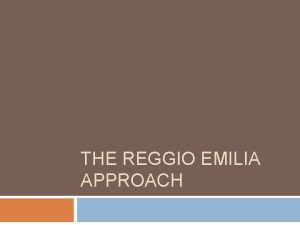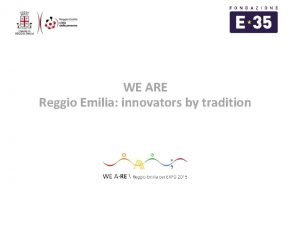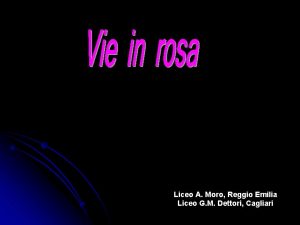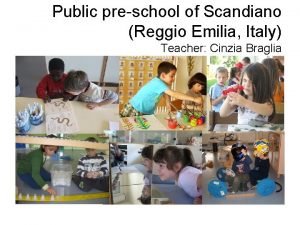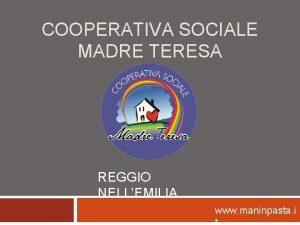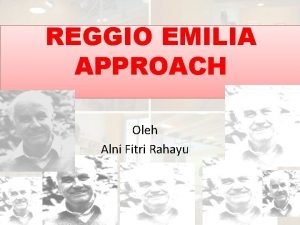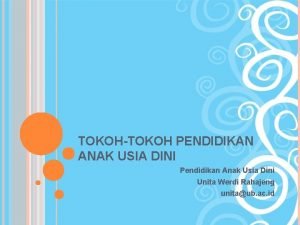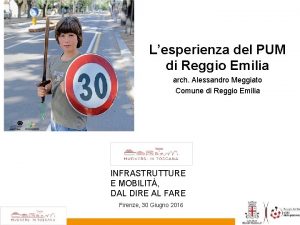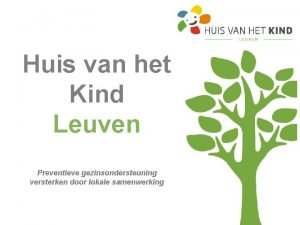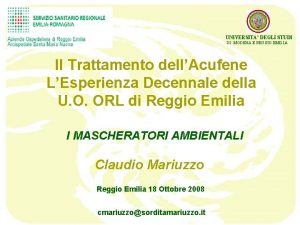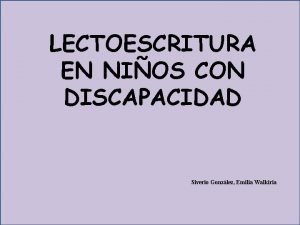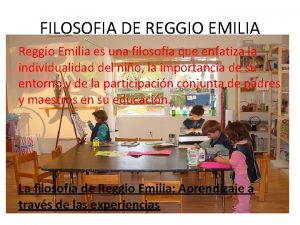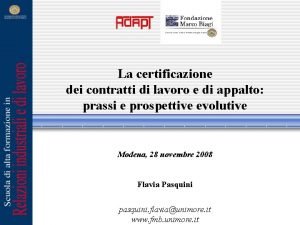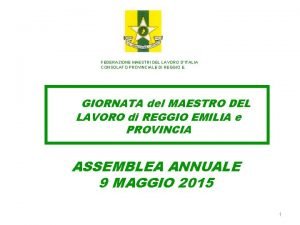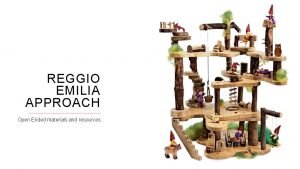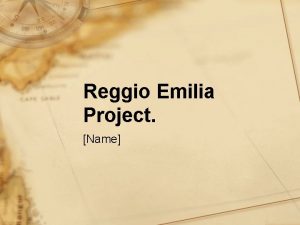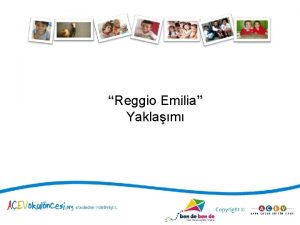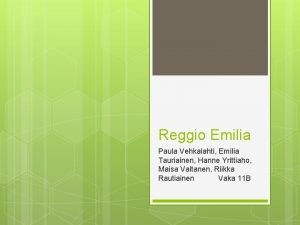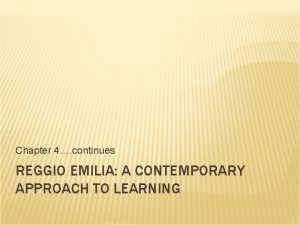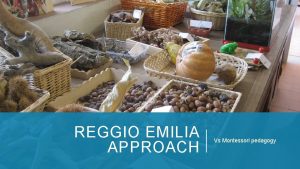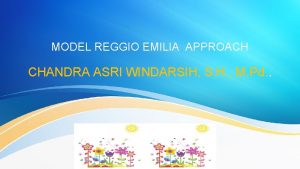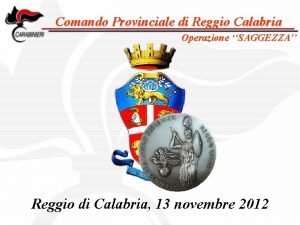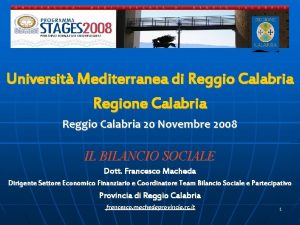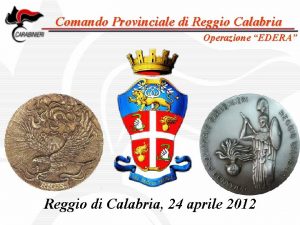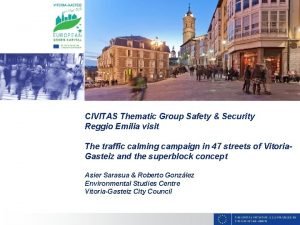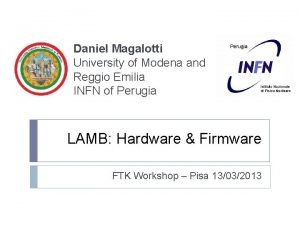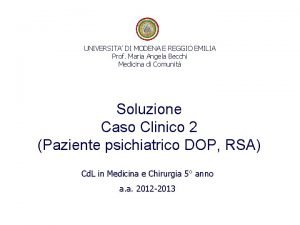The Reggio Emilia Approach What is Reggio Emilia

















- Slides: 17

The Reggio Emilia Approach

What is Reggio Emilia? • Prosperous town in Northern Italy • An approach based on children’s ideas, thoughts and observations • Founded by Loris Malaguzzi • Inspiration from -Vygotsky, -Dewey, -Piaget -Bruner • A Hundred Languages of Children

Reggio Emilia – A Hundred Languages The child Is made of one hundred. The child has A hundred languages A hundred hands A hundred thoughts A hundred ways of thinking Of playing, of speaking. A hundred always a hundred Ways of listening of marvelling of loving A hundred joys For singing and understanding A hundred worlds To discover A hundred worlds To invent A hundred worlds To dream The child has A hundred languages (and a hundred more) But they steal ninety-nine The school and the culture Separate the head from the body They tell the child; To think without hands To do without head To listen and not to speak To understand without joy To love and to marvel Only at Easter and Christmas They tell the child: To discover the world already there And of the hundred They steal ninety-nine They tell the child: That work and play Reality and fantasy Science and imagination Sky and earth Reason and dream Are things That do not belong together And thus they tell the child That the hundred is not there The child says: NO WAY the hundred is there-The Hundred Languages of Childhood By Loris Malaguzzi

The Reggio Guiding Principles • The child as a protagonist, collaborator and communicator • The teacher as a partner, nurturer, guide and researcher • Cooperation as the foundation of the educational system • The environment as the third’ teacher • The parent as partner • Documentation as communication










Reggio Emilia Projects • Can emerge from children’s ideas and/or interests • Can be introduced by practitioners knowing what is of interest to children: - shadows - puddles - tall buildings - construction Sites - heavy equipment - nature • Should be long enough to develop over time, to discuss new ideas, to revisit and see progress • Should be personal from real experiences and important to the children

Reggio Emilia – Pause for Thought • Children are seen as having ‘Special Rights’ NOT ‘Special Needs’ - One child with autism was allowed to roam around the setting for several months while the teachers observed her to find out what was interesting and motivating for her • Time out is not used – The philosophy that each child is accepted for his/her own unique learning style. - A child who is very active is not seen as a problem but as a child who needs to move around during the day.

Reggio Emilia – Reflections • Take time to listen and know what you are listening for • Listen to each child’s melody • Provide space to and time to be alone • Keep boredom away • Value the process of thinking • Ask ‘Why? ’ • Help children ask ‘why? ’ • Question everything • Seek truth, but realise that there is no one truth • Accept and value differences • Shun the stigma associated with a disability • Look further into the reasons for a child’s behaviour • Reflect • Observe, document, interpret • Wait, watch, respond • Do not hurry the child or yourself

Reggio Emilia – Reflect Spend 10 minutes discussing in small groups the pictures and information you have just seen and heard then feedback. Reflect on. . • What aspects of Reggio Emilia are similar to our practice • The practicalities of such an approach for our setting • How we could modify our rooms to reflect such an approach • Your own thoughts on this approach – good or bad
 History of reggio emilia approach
History of reggio emilia approach Reggio emilia
Reggio emilia Moro reggio emilia
Moro reggio emilia Reggio emilia italy preschool
Reggio emilia italy preschool Madre teresa cooperativa sociale
Madre teresa cooperativa sociale Atelierista
Atelierista Reggio emilia
Reggio emilia Pums reggio emilia
Pums reggio emilia Competitors of starbucks
Competitors of starbucks 3 pedagogen reggio emilia
3 pedagogen reggio emilia Henry sound reggio emilia
Henry sound reggio emilia Lectoescritura reggio emilia
Lectoescritura reggio emilia Istituto tecnico turistico motti reggio emilia
Istituto tecnico turistico motti reggio emilia Mutua autogestione
Mutua autogestione Filosofia de reggio emilia
Filosofia de reggio emilia Certificazione contratti reggio emilia
Certificazione contratti reggio emilia Maestri del lavoro reggio emilia
Maestri del lavoro reggio emilia Open ended materials
Open ended materials
